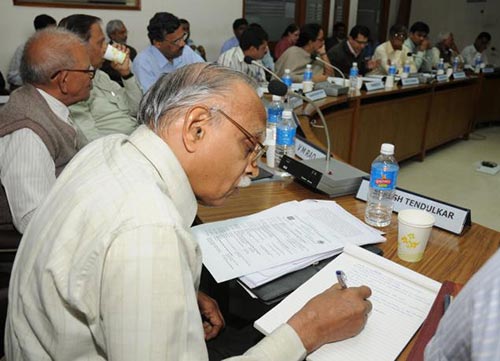
1991 சீர்திருத்தம் – வறுமையின் நிலை என்ன ?முதல் பாகம்
1991 இல் தனியார்மய-தாராளமய-உலகமயக் கொள்ளைகள் இந்தியாவில் சீர்திருத்தம் எனும் பெயரில் திறந்து விடப்பட்டன. இந்த ஜூலை மாதத்தோடு 25 ஆண்டுகள் ஆகிறது. இந்த 25 வருடங்களில் இக்கொள்கைளால் இந்தியா ‘வளர்ச்சி’ பெற்றுவிட்டதாக பத்திரிக்கைகள் லேகியக் கட்டுரைகளை வெளியிட்டு வருகின்றன. இதில் முன்னணியில் இருக்கும் தி இந்து ஆங்கில நாளேடு, 25வருடங்களில் இந்தியாவின் வளர்ச்சி என்பதற்கு ஒன்பது அம்சங்களை ஒப்பிட்டு வரைபடங்களை வெளியிட்டிருக்கின்றது.
1) மொத்த உள்நாட்டு உற்பத்தி (GDP), 2) விவசாயம்-தொழிற்துறை-சேவைத்துறைகளின் வளர்ச்சி, 3) போக்குவரத்து சாலைகளின் நீளம், 4) கம்பெனிகளின் எண்ணிக்கை, 5) அன்னிய நேரடி முதலீடு வரத்து, 6) அன்னிய செலவாணி கையிருப்பு, 7) தொலைபேசி வைத்திருப்பவர்கள் எண்ணிக்கை, 8) கல்லூரிகளின் எண்ணிக்கை, 9) வறுமை ஒழிப்பு ஆகிய ஒன்பது அம்சங்களோடு 1991க்கு முந்தைய நிலையும் தற்போதைய நிலையும் ஒப்பிடப்பட்டிருக்கிறது.
இதில் தனியார்மய கொள்கைகள் வறுமையை அதிகரித்திருக்கிறதா? குறைத்திருக்கிறதா? எனும் கேள்வி முதன்மையாக வந்து நிற்கிறது. இதற்கு தி இந்து நாளேடு, 1993இல் இந்தியாவில் வறுமைக் கோட்டிற்கு கீழ் இருந்தவர்கள் 45.3% பேர் என்றும் இச்சதவீதம் 2011-2012இல் 21.9% ஆக குறைந்திருக்கிறது என்றும் தனியார்மய சீர்திருத்தத்தைப் பெருமிதத்தோடு பாராட்டியிருக்கிறது.
இந்நிலையில் வினவின் வாசகர் ஒருவர் 1991இல் புகுத்தப்பட்ட தனியார்மயக் கொள்கைகள் இந்தியாவில் என்ன நிலைமையை ஏற்படுத்தியிருக்கிறது என்பதை விளக்குமாறு கேட்டிருந்தார். கூடவே இப்படியொரு நிபந்தனையும் வைத்திருந்தார். “நீர்யானைகளை ஆய்வு செய்பவன் எவ்வாறு சமன மனநிலையில் இருப்பானோ அவ்வாறு உணர்ச்சிவயப்பட்ட கோஷங்கள் இன்றி இது இப்படி என்ற அறிவியல் ரீதியில் அமைந்தால் கூடுதல் போனஸாக இருக்கும்.” என்றார்.
சபாஷ்! சரியான போட்டி! என்ற கதையாக வாசகர் முன்வைக்கும் நீர்யானை ஆய்வுமுறையை அதாவது விருப்பு வெறுப்பற்ற சமன மனநிலை, உணர்ச்சிவசப்பட்ட கோசங்கள் இல்லாது இருப்பது, அறிவியல் அணுகுமுறை ஆகியவற்றை முதலில் தி இந்து ஆங்கில நாளேட்டின் வறுமை ஒழிப்புப் பிரச்சாரத்தோடு சற்று பொருத்திப் பார்த்தோம்.
இதற்காக தி இந்து ஆங்கில நாளேடு வறுமை ஒழிப்பிற்கு முன்வைக்கும் தரவுகளை வாசகர்களின் வசதிக்காக தமிழ்படுத்தி மீண்டும் வரைந்தோம்.
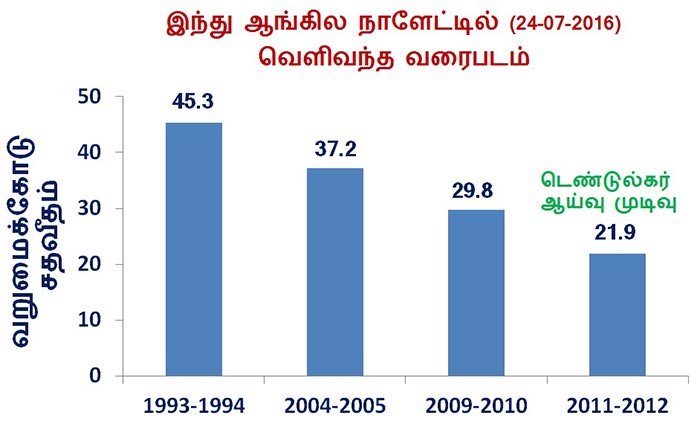
தி இந்துவில் வெளிவந்த இவ்வரைபடம் டெண்டுல்கர் குழுவின் ஆய்வு முடிவை பயன்படுத்தியதாகச் சொல்கிறது. திட்டக் குழு, உலகவங்கி மற்றும் பல்வேறு பொருளாதாரக் குழுக்கள் வெவ்வேறு வறுமைக்கோடு ஆய்வை நிகழ்த்தியிருக்கின்றன. இதில் டெண்டுல்கர் குழுவின் ஆய்வு முடிவை மட்டும் ஏன் இந்து நாளேடு தனிச்சிறப்பாக பயன்படுத்தியது என்பதற்கு எந்தவிதமான தர்க்கப்பூர்வமான விளக்கமும் இல்லை.
சான்றாக வெவ்வேறு காலகட்டங்களில் ஒன்பதுக்கும் மேற்பட்ட வறுமைக்கோடு குறித்த ஆய்வு முடிவுகளை வாசகர்கள் பார்வைக்கு வரைபடமாக வைக்கிறோம். இந்த வரைபடம் RUPEINDIA அரசியல் பொருளாதார ஆய்விதழில் வெளிவந்ததாகும்.
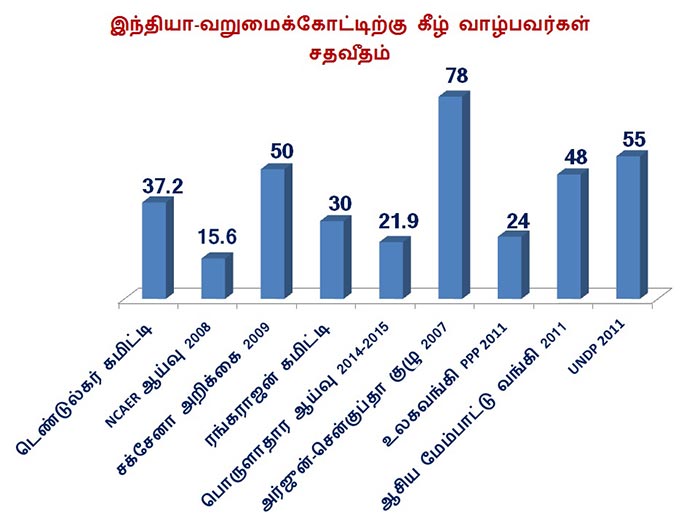
இவ்வரைபடத்தின் படி மிக அதிகபட்சமாக 2007ல் நிகழ்த்திய அர்ஜூன்-சென் குப்தா ஆய்வு, வறுமைக்கோட்டிற்கு கீழ் வாழ்பவர்களை 78% பேர் என்றும் குறைந்தபட்ச சதவீதமாக NCAER-2008 ஆய்வறிக்கை 15.6% பேர் என்றும் கணக்கிடுகிறது.
2009 சக்சேனா அறிக்கை மற்றும் 2011இல் நிகழ்த்தப்பட்ட ஆசிய மேம்பாட்டு வங்கி மற்றும் UNDPயின் அறிக்கை, இரண்டில் ஓர் இந்தியர் வறியவர் என்கிறது. 2014இல் வெளிவந்த ரங்கராஜன் குழு அறிக்கை, மூன்றில் ஓர் இந்தியர் வறியவர் என்கிறது. இதில் எது உண்மை?
தி இந்து நாளேடு வாசகர்கள் பார்வையிலிருந்து வறுமைக்கோடு குறித்த பிற ஆய்வு முடிகளை திட்டமிட்டு மறைக்கிறது. ஆய்வுக் கட்டுரைகளை எழுதும் பொழுது, தான் காட்ட வேண்டிய முடிவிற்காக பிற ஆய்வு முடிவுகளை மேற்கோள் காட்டாமல் விடுகிற இச்செயலை அறிவுத் திருட்டு (Plagiarism) என்பார்கள். இதே செயலை பத்திரிக்கை மற்றும் காட்சி ஊடகங்கள் செய்தால் அதை கருத்து விபச்சாரம் (Prestitution) என்பார்கள்.
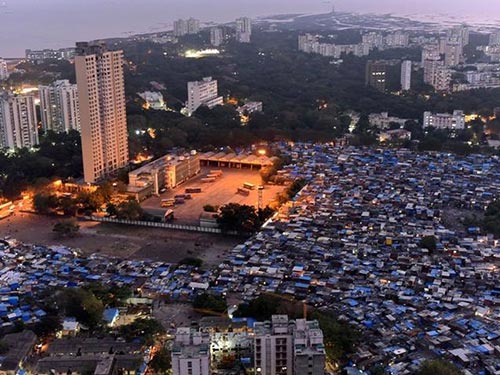
தி இந்து ஆங்கில நாளேடு, இத்தகைய அறிவு நாணயமற்ற செயலை செய்யும் பொழுது சமனமான மனநிலை குறித்து நம் நாட்டு அறிவுஜீவிகள் நம் வாசகர் போன்று கேள்வி எழுப்புவதில்லை! மேலும் தரவுகளைத் திரிக்கும் தி இந்துவின் தனியார்மய பிரச்சாரக் கட்டுரைகள் Tracking Progress in numbers, How economy found its root என்று ஆங்கிலத்தில் உணர்ச்சிப்பூர்வமாக கோசமிடுவதை கண்டும் காணாமல் இருக்கிறார்கள்!
ஏரியல் பவுடருக்கு வரும் விளம்பரம் போல ஆளும் வர்க்க ஊடக செய்திகள் வெண்மையாகவும் உழைக்கும்வர்க்க ஊடக செய்திகள் அழுக்காகவும் அலர்ஜியாகவும் அறிவு ஜீவிகளுக்கு தோன்ற ஆரம்பித்துவிடுகின்றன. இதற்கு என்ன காரணம் என்பதை பிறிதொரு பதிவில் விளக்குவோம். இப்பொழுது வறுமைக்கோடு ஆராய்ச்சியைத் தொடர்வோம்.
மே 30, 2016 அன்று RUPEINDIA அரசியல் பொருளாதார ஆய்விதழில் மனாலி சக்ரபர்த்தி எழுதிய கட்டுரை வறுமைக்கோட்டை நிர்ணயிப்பதில் உள்ள அரசியலை நயம்பட தோலுரித்து. மனாலியின் ஆய்வுக்கட்டுரை அம்சங்களை இக்கட்டுரைக்கு பயன்படுத்தியிருக்கிறோம்.
வறுமைக்கோடு வரையறை
1960களில் திட்டக் குழு, இந்தியாவில் வறுமையில் இருப்பவர்களைக் கணக்கிட ஆரம்பித்தது. 1970களின் ஆரம்பத்தில் வறுமைக்கோட்டை நிர்ணயிப்பதற்கான அடிப்படை முன்வைக்கப்பட்டது. இதன்படி ஊரகப் பகுதியில் தனிநபர், நாள் ஒன்றுக்கு உட்கொள்ளும் உணவு 2400 கலோரியாக இருந்தால் ஒரு மாதத்திற்கு ஆகும் செலவு வறுமையை அளவிட பயன்படுத்தப்பட்டது. இதுவே நகர்புறமாக இருந்தால் தனிநபர் நாள் ஒன்றுக்கு 2100 கலோரி உணவைப் பெறுவதற்கான ஒரு மாதச் செலவு அடிப்படையாகக் கொள்ளப்பட்டது. இம்முறைக்கு MPCE-Monthly Per Capita Consumer Expense என்று பெயர். இதன்படி கிராமப்புறங்களில் 49.09 ரூபாயும் நகர்புறங்களில் 56.64 ரூபாயும் வறுமைக்கோடு நிர்ணயமாக 1973-74இல் பயன்படுத்தப்பட்டது.
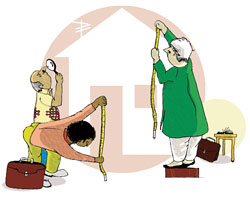
எம்.பி.சி.இ முறையில் உள்ள குறைகள்
ஒவ்வொரு ஆண்டும் பணவீக்கம் அதிகரிக்கும் பொழுது, நுகர்வோர் விலைக்குறியீட்டு எண் (Consumer Price Index) மாறுகிறது. மக்கள் வாங்கும் சக்தியற்றவர்களாக மாற்றப்படுகின்றனர். 73இல் வறுமைக்கோட்டை நிர்ணயிப்பதற்கு மக்களால் வாங்கப்பட்ட உணவுப்பொருட்களின் விலை அடுத்தடுத்த ஆண்டுகளில் அப்படியே இருப்பதில்லை. விலை மட்டுமல்ல; மக்கள் வழக்கமாக உண்ட உணவுப்பொருளும் விலைவாசி காரணமாக உணவுப் பட்டியலில் (Basket of Commodities) இருந்து விடுபடுகிறது. எலும்பிச்ச சாதம் என்ன விலை இருக்கும்? என்று சென்னையில் வசிக்கும் துப்புரவுத்தொழிலாளி வினவு கட்டுரையாளர் சரசம்மாவிடம் கேட்ட கேள்வி இங்கு நினைவிற்கு வருகிறது.
தாறுமாறான விலை உயர்வின் காரணமாக 2400 கலோரி உணவைப் பெறுவதற்கான விலையை எம்.பி.சி.இ வறுமைக்கோடு சுட்டிக்காட்டுவதில்லை. மேலும் எம்.பி.சி.இ முறை, கலோரிகளை மட்டுமே வைத்து வறுமையை அளக்க முயல்கிறது. கல்வி, பொதுசுகாதாரம், உடை, இருப்பிடம் போன்றவை ஏழ்மையை அளவிட பயன்படுத்தப்படவில்லை.
டெண்டுல்கர் குழு அறிக்கை-2009
எம்.பி.சி.இ வறுமைக்கோட்டின் மாறும் தன்மை மற்றும் தனியார்மயத்தை தீவிரப்படுத்த வேண்டியதன் காரணமாக பேராசிரியர் டெண்டுகல்கர் தலைமையில் வறுமைக்கோட்டைக் கணக்கிடுவதற்கு 2005 ஆம் ஆண்டு குழு அமைக்கப்பட்டது. இக்குழு தனது பரிந்துரைகளை 2009 ஆம் ஆண்டு சமர்பித்தது. டெண்டுல்கர் குழு வறுமையைக் கணக்கிடுவதற்கு உணவு கலோரிகள் மட்டுமல்லாது மருத்துவம், கல்வி, நீண்டநாள் பயன்படுத்தும் பொருட்கள் (Durable goods) மற்றும் கேளிக்கை ஆகிய அம்சங்களைச் சேர்த்தது. இதன் நோக்கம் ஏழை ஒருவர் கல்வி கற்கச் சென்றால் அவரை ஏழையாக கருதவேண்டியதில்லை! கட்டில், பீரோ இருந்தால் அவர் ஏழையல்ல! என்பதாகும்.

மேலும் டெண்டுல்கர் குழு நகர்ப் பகுதியில் தனிநபர் ஒரு நாளைக்கு பெற வேண்டிய 2100 கலோரி அளவுள்ள உணவை 1700 கலோரியாக குறைத்தது. ஊரகப்பகுதியில் தனிநபர் ஒரு நாளைக்கு பெற வேண்டிய 2400 கலோரி அளவை 1999 கலோரிகளாக குறைத்தது. இப்படிக் குறைப்பதற்கு இக்குழு ஐக்கிய நாடுகள் சபையின் உணவு மற்றும் வேளாண்மைக் கழகத்தின் (FAO-Food and Agricultural Organization) பரிந்துரையான 1700 கலோரியை மேற்கோள் காட்டியது. ஆனால் FAOவின் 1700 கலோரி மதிப்பானது, நகர்புறத்தில் தனிநபர் ஒருவர் எளிய உடல் உழைப்பில் ஈடுபடுவதற்குத் தேவையான குறைந்தபட்ச உணவுத் தேவையாகும்.
இந்தியாவில் தனியார்மயம் தொழிலாளிகளை சிதறடித்து நகர்புறத்திற்கு வீசி எறிந்திருக்கிறது. இந்தியாவின் பெரும்பாலான பணியாளர்கள் கடும் வேலை உழைப்பில் உழல்பவர்கள். இவர்களுக்கு 1700 கலோரி அளவை பணக்காரன் ஆக்குவதற்கான அளவாக நிர்ணயிப்பது வக்கிரமான செயலாகும்.
மேலும் டெண்டுல்கர் குழு, முதியவர்கள், தனித்து வாழும் பெண்கள், புராதன பழங்குடிகள், விதவைகள், கர்ப்பிணிகள் மற்றும் பால்கொடுக்கும் தாய்மார்கள் ஆகியோரை வறுமைப் பிரிவில் கண்டுகொள்ளவில்லை. ஒருவேளை இவர்கள் ஏதேனும் ஒரு அரசுத் திட்டத்தில் இருந்தால் ஏழையாக கருதவேண்டிய அவசியமில்லை என்ற காரணத்தை இங்கு ஊகிப்பது மிகவும் எளிது.
இப்படித்தான் டெண்டுல்கர் குழு 2005இல் வறுமைக்கோட்டிற்கு கீழ் வாழ்பவர்கள் 37.2% என்று பரிந்துரைத்தது. 2010இல் இந்து ஆங்கில நாளேடு இதே டெண்டுல்கர் குழு அறிக்கையை கடும் பிழையாகிப்போன ஓர் ஆய்வுமுறை (A methodology deeply flawed-The hindu, 05-02- 2010) என்று விமர்சித்தது. இன்றைக்கு இதே நாளிதழ் இந்த ஆய்வுமுறையை வைத்துக்கொண்டு தனியார்மயத்தின் சாதனைகள் என்று பிரச்சாரம் செய்கிறது என்றால் மக்களை எத்துணை பெரிய மாங்கா மடையர்களாக கருதியிருக்க வேண்டும்?
டெண்டுல்கர் குழு, பல்வேறு தகிடுதத்தங்கள் மூலம் வறுமைக்கோட்டை 37.2%க்கு தள்ளினாலும் திறமை பத்தாது என்று ரங்கராஜன் தலைமையில் மத்திய அரசு 2012இல் அடுத்த குழுவை அமைத்தது.

ரங்கராஜன் குழு அறிக்கை-2014
ரங்கராஜன் மன்மோகன் சிங்கின் தலைமைப் பொருளாதார ஆலோசனைக் குழுவின் உறுப்பினராக இருந்தவர். ரங்கராஜன் குழு தனது பரிந்துரைகளை 2014இல் சமர்பித்தது. இவர் நாளொன்றுக்கு தனிநபர் பெற வேண்டிய உணவு கலோரி அளவை நகர்புறத்திற்கு 2155 என்றும் ஊரகப் பகுதிக்கு 2090 என்றும் நிர்ணயித்தார். இது டெண்டுல்கர் குழு நிர்ணயித்த அளவை விட சற்று அதிகம் என்றாலும் ரங்கராஜன் குழு வறுமைக்கோடு எல்லையை நாளொன்றுக்கு கிராமப்புறங்களில் 32 ரூபாய் எனவும் நகரப்புறங்களில் 47 ரூபாய் எனவும் தீர்மானித்தது.
ரங்கராஜனின் சமார்த்தியம் எதில் இருக்கிறது என்றால் வறுமையைக் கணக்கிடுவதற்கு தனிநபர் என்பதற்குப் பதிலாக 32 ரூபாய் சம்பாதிக்கக் கூடிய நான்குபேர் ஒரு வீட்டில் இருந்தால் அவர்கள் ஏழையல்ல என்று முடிவு செய்ததாகும். ரங்கராஜனின் வறுமைக்கோடு அளவு 30% ஆக நின்றது.
இதுதவிர மாண்டேக்-சிங் அலுவாலியாவின் 28 ரூபாய் பணக்காரன் ஆன கதை மற்றும் ஏழை பத்ரி-சேசாத்ரியின் வாக்குமூலம் நம் அனைவருக்கும் ஓரளவு தெரியும் என்பதால் இதை இங்கே தவிர்த்துவிடுவோம்.
சக்சேனா குழு அறிக்கை-2009
2008இல் மத்திய ஊரக மேம்பாட்டுத் துறை அமைச்சகம், மாற்று வழிகளில் வறுமைக் கோட்டை ஆராய்வதற்கு N.C. சக்சேனா தலைமையில் குழு ஒன்று அமைத்தது. சக்சேனா குழு 2009இல் தனது அறிக்கையை சமர்பித்தது. திட்டக் குழு நிர்ணயித்த குறைந்தபட்ச உணவிற்கான தொகை மிகவும் குறைவு என்று சக்சேனா குழு கருதியது. எனவே ஊரகப்பகுதியில் மாதம் ஒன்று 356 ரூபாயாக இருந்த குறைந்தபட்ச எல்லையை ரூ. 700 ஆக உயர்த்தியது. நகர்புறத்திற்கு குறைந்தபட்ச உணவுத் தேவைக்கு மாதம் ஒன்றிற்கு ரூ.1000 என்று நிர்ணயித்தது. இப்படிச் செய்தால் சக்சேனா குழு ஆய்வின்படி இரண்டில் ஓர் இந்தியர் (50%) ஏழையாவார். இத்துணைக்கும் சக்சேனா குழு, உணவுக்கான கலோரி அளவை 2400 என்று வைப்பதற்குப் பதிலாக 2100 கலோரிகள் என்றே கணக்கிட்டது. குறைந்தபட்ச உணவுத் தேவை நாளொன்றுக்கு 2400 கலோரிகள் என்று வைத்தால் இந்தியாவின் 80% மக்களை ஏழைகளாக கணக்கிட வேண்டும்!
அர்ஜூன்-சென்குப்தா குழு அறிக்கை-2007
நாட்டில் 90% தொழிலாளிகள் எந்த அமைப்பையும் சாராதவர்கள். அதாவது அமைப்பு சாரா தொழிலாளிகள் (Unorganized workers). விவசாயக் கூலிகள், பாலம் கட்டுபவர்கள், தெரு வியாபாரிகள், சாலைப் பணியாளர்கள், தள்ளுவண்டிக் கடைகள் என்று இவர்களின் பட்டியல் நீள்கிறது. மொத்த தேசிய உற்பத்தியில் 50% அமைப்பு சாரா துறையில் இருந்து வருகிறது.
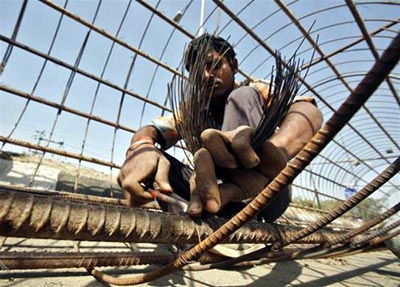
அமைப்புசார தொழிலாளிகளின் வாழ்வை மேம்படுத்துவதற்காக அமைப்புசார நிறுவனங்களுக்கான தேசிய ஆணையம் (NCEUS-National Commission for Enterprises in Unorganized Sector), பேராசிரியர் அர்ஜூன் சென்குப்தா தலைமையில் 2004இல் வறுமையை கணக்கிட குழு ஒன்றை அமைத்தது. சென்குப்தா குழு அமைப்புசாரா தொழிலாளி ஒருவர் வறுமையில் இருப்பதை கண்டறிவதற்கு நாளொன்றுக்கு ரூ.20 ரூபாய் எனும் குறைந்தபட்ச குறீயிட்டை நிர்ணயித்தது. இந்த நிர்ணயித்தின்படி நாட்டின் 78% மக்கள் வறுமைக்கோட்டிற்கு கீழ் வாழ்பவர்கள்.
உலகவங்கி அறிக்கை 2011
மக்களின் வாங்கும் சக்தி வேறுபாட்டை (PPP- Power Purchase Parity) அடிப்படையாகக் கொண்டு உலகவங்கி இந்தியாவில் 2011இல் வறுமைக்கோட்டிற்கு கீழ் வாழ்பவர்கள் 26% பேர் என்றது. PPP யை துல்லியமாகக் கணக்கிட்டால் 2011-2012இல் வறுமைக்கோட்டின் சதவீதம் 12.4% ஆக இருக்கும் என்றும் உலக வங்கி சொல்கிறது. உலகவங்கியின் ஆய்வுமுறை இன்னதென்று தெரியாவிட்டாலும் இந்த உலகவங்கியின் விருப்பத்தை நிறைவேற்றத்தான் 1973 லிருந்து திட்டக் குழு எனும் பெயரில் உலகவங்கியின் சேவகர்கள் நரசிம்மராவ், அலுவாலியா, டெண்டுல்கர், ரங்கராஜன், மன்மோகன் சிங், வாஜ்பேய் என்று பலரும் பல்வேறு வறுமைக்கோடு ஆய்வுகளை நிகழ்த்தியிருக்கிறார்கள்.
திட்டக் குழு வறுமைக்கோட்டை ஏன் கணக்கிடுகிறது?
தனியார்மயக் கொள்கைகளை அமல்படுத்துகிற பொழுது மக்களைப் பாதுகாப்பதற்கான அடிப்படைக் கடமைகளான அரசின் பொதுத்திட்டங்கள் இடைஞ்சலாக இருக்கின்றன. சுதந்திர சந்தைக்கு பொது வினியோகம் காவு கொடுக்கப்படவேண்டும். பொதுசுகாதாரம் திறந்துவிடப்பட வேண்டும். சான்றாக 30 ஆண்டுகளுக்கு முன்பாக அரசு மருத்துவமனைகள் என்பது அனைத்து தரப்பு மக்களின் சேவைக்காக இருந்தது. தனியார்மயக் கொள்கைகள் அமல்படுத்தப்பட்ட பிறகு, இல்லாதவர்களுக்கு மட்டும் அரசு மருத்துவமனை, அரசுப்பள்ளி, ரேசன் கடை என்று மாற்றப்பட்டிருக்கிறது.
குடிமகன்கள் என்ற நிலையிலிருந்து மக்களை நுகர்வோர்களாக மாற்றுவது தான் திட்டக் குழுவின் வேலை! இதைச் செய்வதற்கும் அரசின் கடமைகளை கைகழுவுவதற்கும்தான் வறுமைக்கோடு கணக்கிடப்பட்டதேயன்றி வறுமையை ஒழிப்பதற்காக அல்ல!
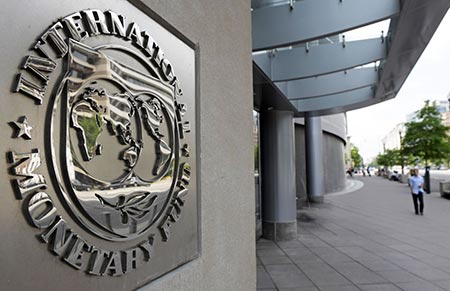
அப்படியானால் வறுமை ஒழிப்பின் சதவீதம் என்ன?
2011-2012 உலகவங்கி அறிக்கையின் படி இந்தியாவின் வறுமைக்கோடு வெறும் 12.4% மட்டுமே. இப்பொழுது மோடியின் ஆட்சியில் திட்டக் குழுவே கிடையாது. எனில் உலகவங்கியின் டார்கெட்டை மோடி கும்பல் நிறைவேற்றிவிட்டது என்றாகிறது. இதன் அர்த்தம் அரசின் அதிகாரப்பூர்வ ஏடுகளின் படி நாட்டில் வறுமையில் வாடுபவர்கள் யாரும் இல்லை! 1991 தனியார்மய சீர்திருத்தத்தின் சாதனை இது! அப்படியானால் நாட்டின் 80% மக்கள் ஏழைகள் என்ற ஆய்வு முடிவின் கதி! நீங்கள் இதை உண்மையென்று ஏற்கலாம். அல்லது பொய்யென்று மறுக்கலாம். ஆனால் 80% மக்கள் நுகர்வோர்கள். எலுமிச்சை சாதத்தின் விலை அறியாத நுகர்வோர்கள் அவர்கள்!
– இளங்கோ
பின் குறிப்பு: 1991 தனியார்மயக் கொள்கை மற்றும் மொத்த உள்நாட்டு உற்பத்தி எனும் அம்சத்தை அடுத்த பதிவில் பார்ப்போம்.
இரண்டாம் பாகம் – 1991 தனியார்மய சீர்திருத்தம் – பலன் யாருக்கு ? சிறப்புக் கட்டுரை
மேற்கோள் கட்டுரைகள்:
Tracking progress in numbers
Why the Poor Do Not Count
A methodology deeply flawed
